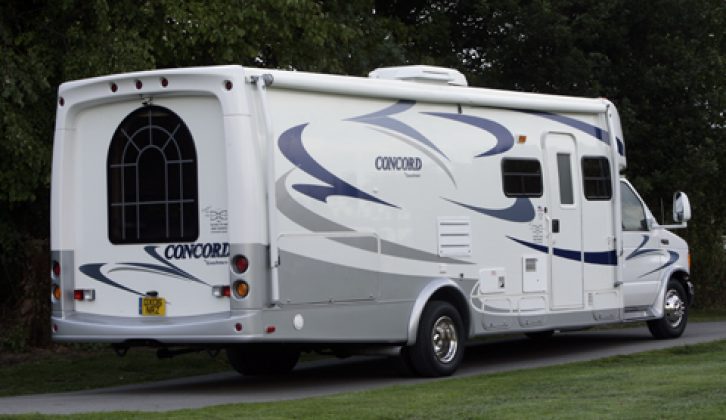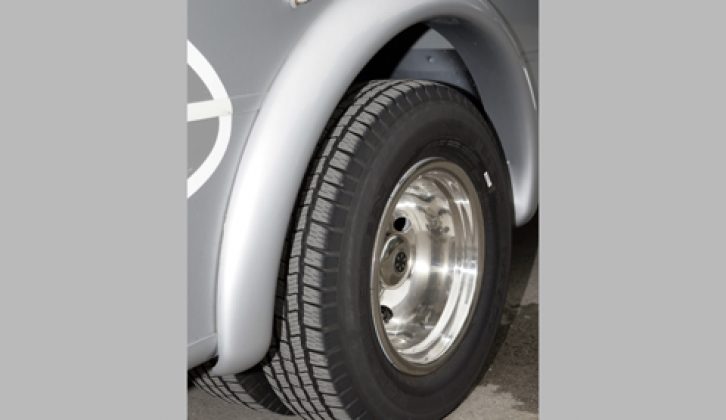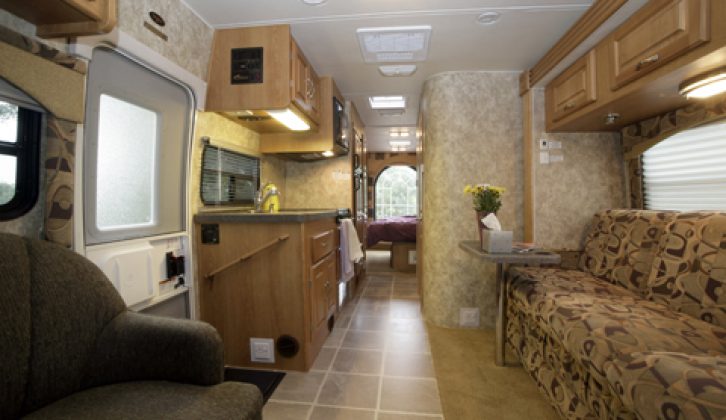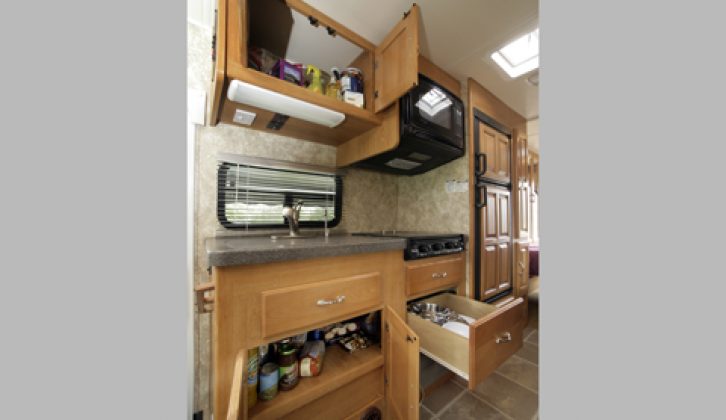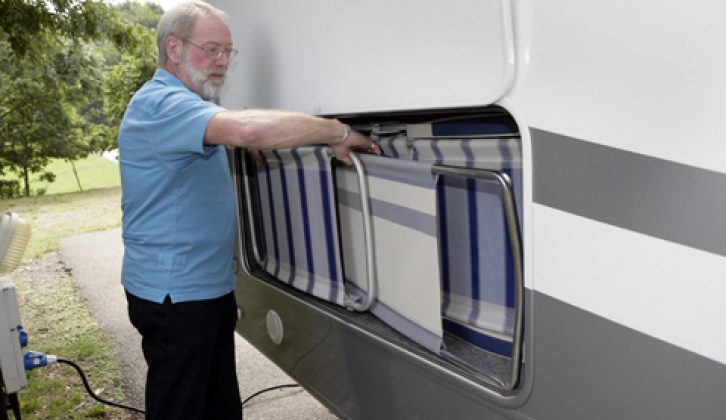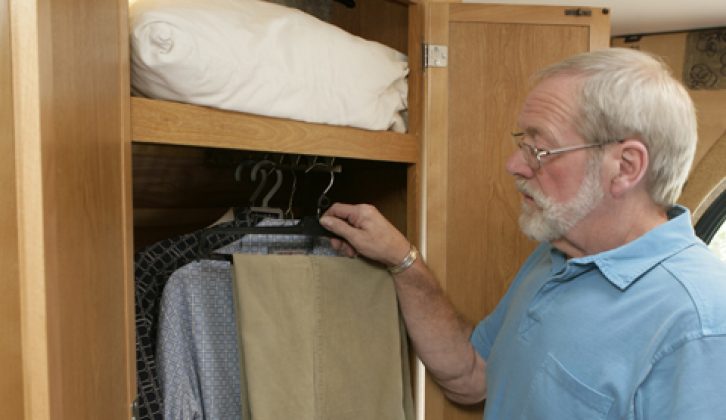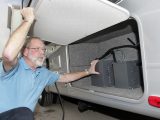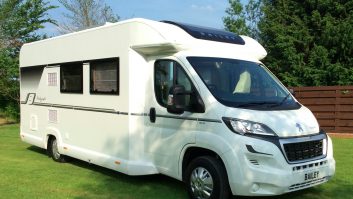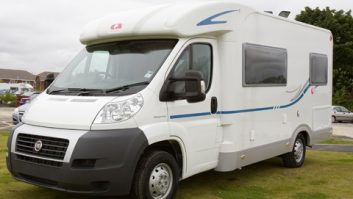Verdict
You get a lot of motorhome for your money. In terms of specification and living space, the Concord beats European competitors hands-down and is cheaper than most. The sticking points? First, fuel economy. The 6.0-litre diesel is designed for a country where fuel is cheap. Second, there’s build quality. We’ve no doubt this Coachmen will weather well and do its job, but its finish is not as neat and crafted as a European ’van. Yet it is often far, far sturdier. In conclusion, for long-range touring space and driveability, the Coachmen is hard to beat.
Pros
The Ford E450’s torque, relaxing seats, and full auto ‘box; unusual arch-shaped window; fixed toilet tanks
Cons
Finish isn’t all that tidy; filling the fuel tank (huge and expensive); mirrors on every wardrobe door; lockers weren’t quite big enough
Mention American motorhomes and most people think of the coach-sized, luxurious A-class, beloved of movie stars. However, this 30ft Coachmen Concord 275 DS is described as a ‘mini motorhome’.
It’s as big as the larger European A-classes, and it’s against these that it is best compared in terms of price, size and specification. In terms of design approach, European and US motorhomes are poles apart. What marks this Coachmen out is that it offers superb living space and standard specification in a relatively small package and at a comparatively low price. Yes, it costs £70,000, but if you spend months at a time in your ’van, the Concord can be driven off the forecourt and into the wide blue yonder without any optional extras.
Living
Were it not for unsatisfactory dining arrangements, the Coachmen would have been close to full marks, simply because, with the lounge slide-out open, there’s a greater sense of space than in most motorhomes. It’s a simple fact that will always give US motorhomes an advantage. That’s invaluable for couples spending long periods in each other’s company – or for those who spend a lot of time at outdoor events where there are no facilities.
Add a custom-built entertainment centre (which includes a flatscreen television for 2007 models), a domestic-quality sofa-bed and a swivel armchair (a free-standing recliner in 2007) and you have a space where two or three people can spend a whole evening without getting under each others’ feet.
Rear speakers across the cab deliver a signal from the radio which runs off the leisure 12V system, as well as from the standard-fit TV and this model’s optional VCR/DVD. We found the reception from the omni-directional TV aerial poor at our campsite, and digital users may need to get a directional aerial fitted.
The single-glazed glass windows don’t look large in proportion to the 6ft 6in-tall living space, but they’re a similar size to those on European ’vans. There’s a permanent flyscreen panel over the opening window section: this only amounts to a third of each window space, so you’re a bit more reliant on the air conditioning, which we felt was too noisy to use after 11pm on most campsites (depending on the proximity of your neighbours). However, there is a full-door flyscreen with a sturdy catch. The hefty window-frames obscure the views a little, but these were superb from our pitch in the Peak District National Park.
Light floods in from the rear window and from the textured-glass door window. There are no panoramic rooflights, though there is a small rooflight behind the cab, with a three-way extractor fan that has a winter heating element. The frosted-glass main light and central lounge light are attractive and have a weighty, domestic quality to them. There are spotlights over the armchair and sofa, three-pin sockets by the entrance door and sofa, and heating/air-con vents at the base of the kitchen unit.
Criticism is reserved for the two small, slightly unstable, single-leg removable tables. They’re fine if you want to eat all your meals in front of the telly, but not for socialising. The seating in the lounge area would seat four comfortably, five adequately, though Travelworld can retro-fit swivel cab seats. Alternatively, there’s an optional U-shaped dinette in place of the sofa, at no additional cost. We liked having a large television and DVD player, but found it positioned too high for comfortable viewing. For dining, the table was completely inadequate: unstable, too small and too close to the seating. You’d be better off with a tray on your knee.
The flooring in the lounge was attractive and practical. The carpet gave a feeling of warmth, while the flagstone-look vinyl could be easily cleaned.
Kitchen
The kitchen isn’t huge, but the twin sinks with solid worktop covers make food preparation easy, with ample room for chopping vegetables between the left sink and hob if you keep the right sink cover in place.
The eye-level convection oven/microwave covers a lot of bases, but it’s not a ‘proper’ gas oven. However, the hob is of domestic size and the ultra-hard-wearing worksurface has none of the flimsy feel of some motorhome kitchens.
Then there’s the fridge: many mid-price ’vans have a 150-litre fridge as standard, but it’s still a pleasant surprise to look inside the sturdy, spacious, wood-panelled fridge door and find almost double that capacity. Automatic energy selection and temperature control is convenient, and soon had the freezer ice-cold. We were impressed by the automatic locking door catches.
There isn’t enough preparation space, however. You’re forced to use the rickety table, which in turn would encroach on the lounge area. However, the over-hob extractor fan work well and aren’t too noisy, and both the hob and the working area are well-lit.
Washroom
Like the kitchen, this centre washroom is not much bigger than those of European motorhomes. The pedal-flush Thetford toilet is more comfortable than the usual swivel-bowl arrangement, with a big holding tank and a powerful flush, though the seat is quite high. There is easy access to the large, ABS plastic sink, with an attractive brushed-steel mixer tap, a wide surround, and sink-to-ceiling mirrors behind it, as well as on the right-hand corner of the wall.
When it came to emptying the toilet tank, we easily found an appropriate mains sewer drain at our campsite (though we’d called ahead to check). We found it no more inconvenient than emptying a cassette; in fact, you’re much further away from the ‘business end’, and you simply add your chemicals and some water via the loo itself to refresh the tank.
There is a separate shower cubicle in the washroom with just about sufficient headroom for a 6ft-tall person, but we felt the shower screen was flimsy. We did discover a small leak through this pleated, vinyl screen when we used the shower but this could easily be sorted. Crucially, the shower head has a cut-off switch for economical water use. Even with the Concord’s 23-litre gas/electric water heater, the fixed shower head is not positioned high enough for anyone who is much over 5ft tall. An extractor fan within a clear rooflight adds ventilation, and a translucent, fixed dome rooflight sits above the shower.
The only disruption was the Shurflo pump, which caused an audible vibration every time it was used.
Beds
In this respect, the Concord 275DS achieves full marks, with its domestic-quality, interior-sprung mattress on a walk-round double bed. Add to that the large rear window and you have a genuine bedroom, with a pleated, concertina blind dividing it from the main living area.
The sofa makes up to a flat double – albeit with a narrow trench down the middle – in two simple movements: just lift the seat cushion so that the back cushion lies flat, then let the seat slide down flat again. The only difficulty for guests who are using this bed is keeping the light out: a thin, lined curtain attaches across the cab with Velcro tabs but there’s nothing to stop the light coming in through the textured-glass door window.
There’s a TV shelf to the right of the twin wardrobes in the bedroom; the mirrored fronts seem a little excessive, but add some sense of space.
There’s no headboard, but you can lean back against the pleated fabric blinds without risking damage; these are lightly tensioned by a cord attached at either side of the bed. There are three-pin plugs and shelves on either side, though we found the quiet humming of the electrical transformer that lives under the bed too noisy on the first night. By the second night it was no longer noticeable, but light sleepers beware.
Storage
On balance, there’s a lot of space inside the Concord. The motorhome’s interior storage compartments provide enough room for a couple to store their bits and bobs for a month or more. However, exterior storage is poor for a vehicle of the Concord’s size, although all the lockers have a single key and are easy to open.
There is a rear UK-offside locker that could hold two standard folding chairs, but was a bit shallow for our two recliners. The 4kW generator, which provides mains power for appliances like the TV, oven/microwave and roof air-con, is in a skirt locker behind the driver’s door, with a similar shallow locker behind it.
The generator is very useful, but far too noisy for campsite use. The gas tank is on the opposite side: its connections are secured, so there’s no need to switch on and off whenever you pitch camp. Two lockers behind the habitation door house, respectively, the twin leisure batteries and a space big enough for a water hose and an extension power cable.
The nearside corner locker is home to the electrical systems, though there’s room for some large levelling ramps. In front of this you’ll find the grouped water, waste and electrical services and in front of these, in the lounge slide-out, there’s the only locker of any great depth: about 60cm (2ft) deep, the same width and around 30cm (1ft) tall. The standard detachable towbar is superb value.
Inside, you may want to add storage bins; the three lockers above the sofa access a huge space that’s 2ft deep but with no dividing internal walls. There are no catches on these lockers, either, though the hefty doors will keep most items lighter than a hardback novel secure.
The kitchen drawers have no catches, but need to be lifted to allow them to open, which keeps them snugly in place on the road. Despite having thrown in loads of pots and pans, the kitchen stayed quiet on-road, though the small, under-sink drawer has no divisions for cutlery. The shallow drawer under the hob was ideal for the sink covers and oven plate, while deep drawers beneath this and the fridge took larger items.
The two double cupboards over the sinks and on the floor below can hold lots of tins and packets, a 500g cereal box and a three-part stacking steamer set. The lower cupboard also houses the large-bore, domestic-style plumbing, which includes domestic-sized plugholes.
In the bathroom, there’s a towel rail behind the loo, a couple of bottle shelves in the shower, and three cupboards and a drawer. The bedroom has three overhead lockers, a chest of drawers and two large wardrobes with dedicated clothes-hanger slots to keep hangers from falling to the floor in transit.
Finally, around the cab, there are TV/hi-fi cabinets above, with glass-fronted shelves for videos and DVDs either side. With a magnetic push-catch and a small restraining clip, these are not suitable for heavy items. In the four slim, glass-fronted lockers at either side of the cab, there’s space for up to 12 (75cl) wine or spirit bottles, though it would be wise to fit cushioned bottle holders with straps.
Technical Specifications
| Payload | 805 kg |
| MTPLM | 6373 kg |
| Shipping Length | 9.04 m |
| Width | 2.36 m |

